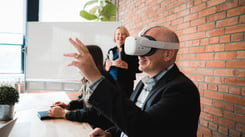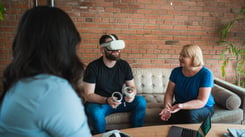Virtual Reality (VR) is a piece of advanced technology that has recently become popular across various industries. Although the tech is most commonly associated with the entertainment industry, VR’s flexibility and adaptability have been successful in Enterprise too. From real estate to hospitality, the opportunities for applying VR into your workflow are endless. One such industry that has been greatly affected by VR is the architecture industry.
For those in architecture, being able to visualize a design is one of the most crucial steps in the design process. VR has become an asset in architecture, allowing designers to step into their design and see their vision with clarity. By having a greater understanding of scale, proportion, and texture, using VR in architecture has become a viable business solution.
However, VR is a powerful and adaptable tool that does not only enhance your internal design process. This technology also has the ability to transform all external interactions you may have with your clients.
Create a Perfect Understanding
Diamond Schmitt Architects (DSAI) had recently partnered with Ingenium, Canada’s Museum of Science and Innovation to design an adjacent building to the Canada Science and Technology Museum in Ottawa. Designing the new building was a huge project, prompting DSAI to dabble with advanced tools that would help both the designers and clients understand the project better. The VR portion started off as a side project. However, it quickly progressed into an asset promoting better communication between DSAI and their client.
“Before VR, the client understood the concept, but didn’t feel the visceral connection. We noticed a much more emotional response once they viewed our design in VR, in contrast to an almost clinical approach when they looked at plans.”
- Andrew Chung, Diamond Schmitt Architects
Using Virtual Reality in architecture allows you to create a perfect understanding between you and your client. Try and think from your client’s perspective. Your design team may be well acquainted with looking at a floorplan but your client may not be as familiar. With the ability to step into the design, your clients will be able to orient themselves with a better understanding of the space. Plus, it gives you the opportunity to carry on the conversation. Andrew found that “the client engaged in a dialogue with [them] much more frequently”. By showing rather than telling, effectively communicate with your clients with greater clarity, and generate more continuous conversation.
Actions Speak Louder than Words
Again, put yourself in your client’s shoes. When teaming up with an architecture firm for a project, what makes for an exceptional experience? What would convince you to not only seek their services in the future but also tell others about it? Sure, one key characteristic is clear communication. However, as a client, being heard and understood is another key component. Receiving timely and accurate changes based on the feedback submitted is arguably the most important for a client-to-business relationship. Not only does this show that you are attentive to your client’s vision, but it also shows that you are committed and active in the design process. Although this may be intuitive, it is always better to remember that when your clients see changes made based on their comments, your actions now become tangible to them.
Nowadays, VR has become even more advanced than ever before. As such, features like recording feedback while in the VR environment is now possible and available. Yulio’s newest feature, Project Markup, allows you to do just that. Launching a Collaborate session allows you to draw directly on your VR project to highlight edits and lets your clients see them applied in real time. By giving your clients the opportunity to see your comments, you show that you actively listening, engaged in the revision process, and committed to achieving their vision.

Decide Easier, Better, and Quicker
Revisions take time, and the constant back and forth between client and designer is quite costly. However, with VR, you are now able to cut the number of meeting times significantly. There are two main ways that VR is a solution to this inconvenience:
Confidence and Trust
Similar to the previous point, showing your client that you have understood their vision is an important part of building a solid relationship between you and your client. Not only does this establish trust between both parties, but also confidence in your abilities on delivering their vision. The more your client has confidence in your skills, the more they will trust you in the decision making process. This will help both the client decide quicker, but also you as a designer receive the feedback needed in a timely manner. As a result, both the client and designer greatly benefit.
Seeing is Believing
Being able to see a space with your eyes makes a huge difference. However, it may be more difficult for your client to understand your plan and give insightful feedback based on it.
“Architects and designers often forget they’ve been training for years to understand and interpret design drawings. There is a struggle in ensuring there’s a connection between what we conceive and what the clients perceive. Allowing spaces to be viewed in VR makes our process more streamlined.”
- Alex Garrison, Gensler
Whether you are presenting different layout options or wanting your client’s opinion on a specific area, presenting it in VR could reduce the gap between designer and client. Get answers like “I don’t think this captures our vision” or “this is absolutely perfect” by showing your clients rather than just telling.
Experience the Benefits of a Deeper Client Relationship of Using VR in Architecture
So far, we have explored the benefits of implementing VR in architecture by fostering a greater connection with your clients. However, this process actually encourages a symbiotic relationship between both client and designer. As the client is receiving what they need from the designer, the designer is also being pushed out of their comfort zone and challenged to be the best designer they can be. With bigger and more unique projects coming your way, the various opportunities will stretch your repertoire, adding to your already existing and extensive skillset. Begin building a deeper connection with your clients, and set yourself from the others with VR.
Here at Yulio, we strive for excellence in performance and integrity when it comes to our product, and customer service. Want to hear more winning VR stories? Check out these case studies of companies successfully integrating VR into their business here. Check out our Whitepaper on the right way to integrate VR into your business for maximum ROI.
Original post from April 11, 2019.







